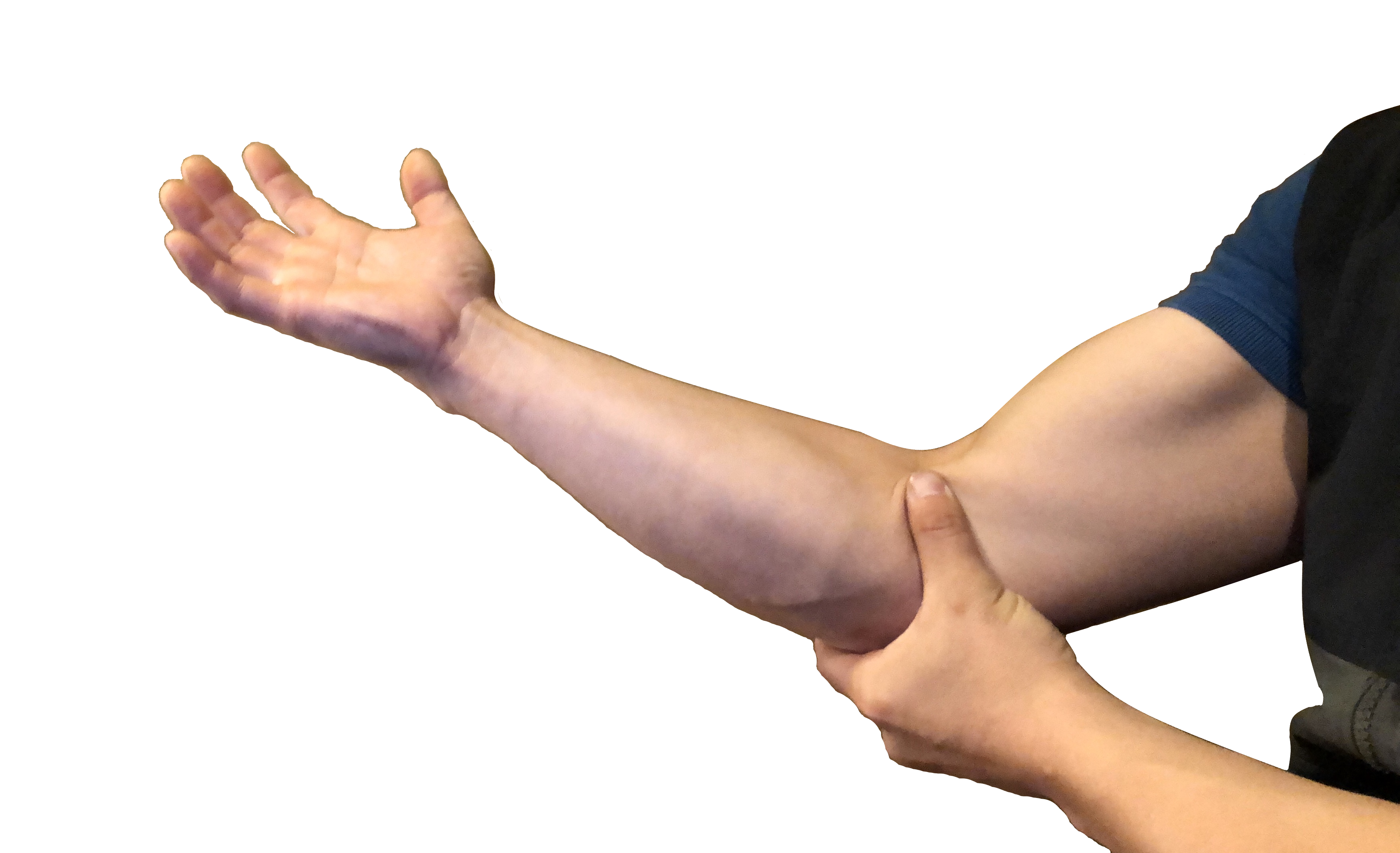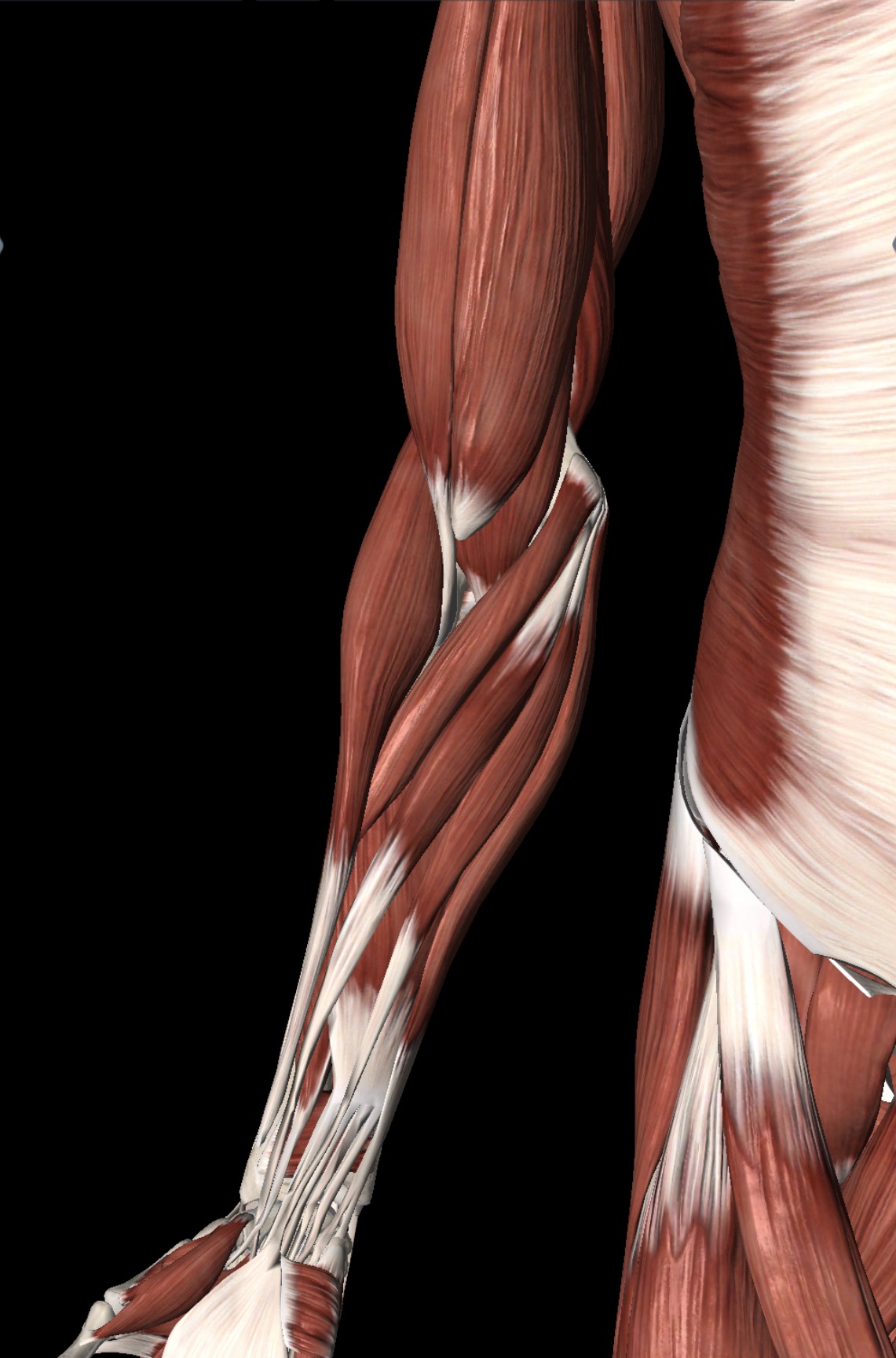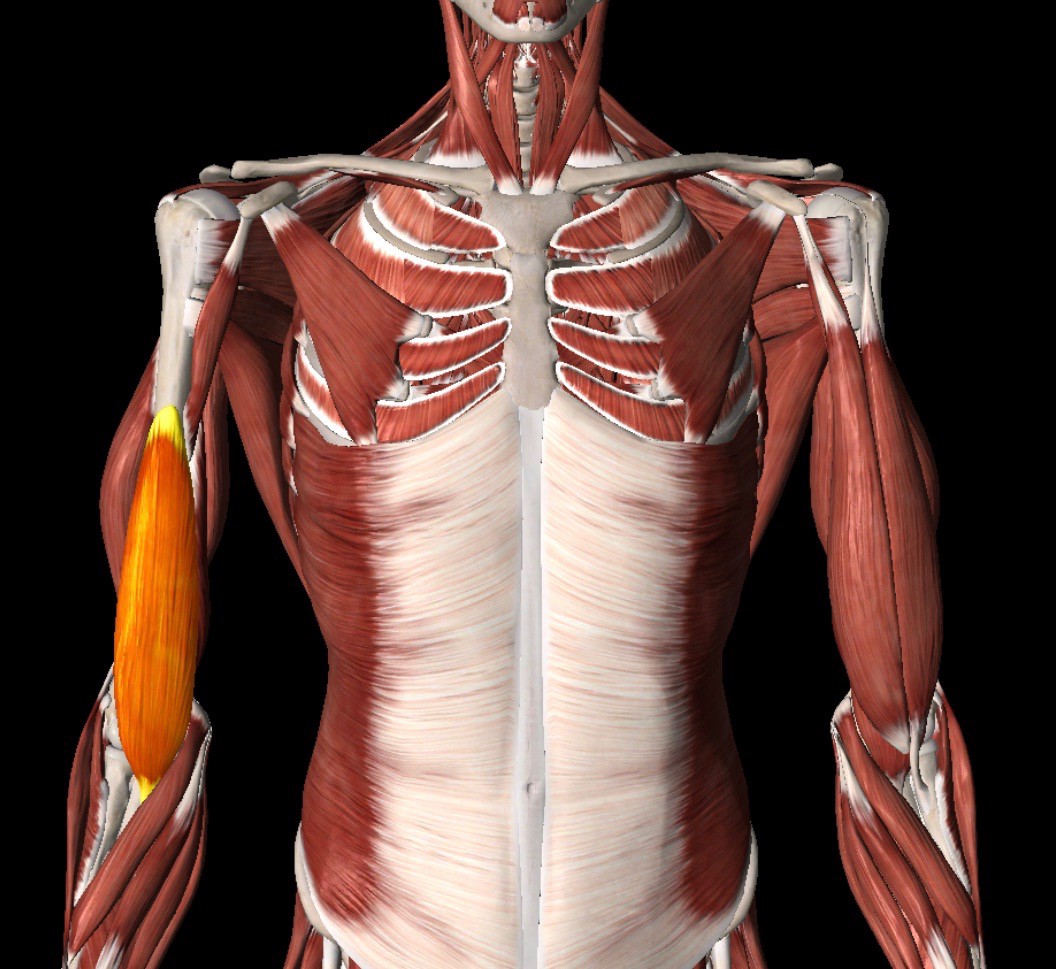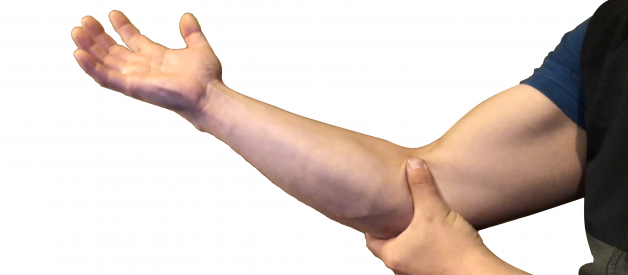
Who would have thought 16 muscles cross the elbow joint!?
Climber?s elbow is a topic I?ve been meaning to write about for some time. But the hurdle for me, like many other complicated topics, is that the information is vast. There are many different factors involved that it?s hard to know where to begin. To name a few that may influence the treatment plan: Years of climbing. What grades are you flashing/sending/projecting? Frequency of climbing. Was there a mechanism of injury. Duration of your injury. What aggravates it and what makes it feel better? Do you work wrist extension exercises? That affects how hard you can pinch. If you?re using those rubber rods to work on wrist strengthening then why do you still hurt? Maybe you?re only really strengthening your fingers and not your wrist. Strong finger flexion strength can mask weak wrist flexion strength which is why your sloper game may be poor. Wrist extension may be strong with a closed hand but very weak in an open hand position. Is there any nerve tension? And the list goes on and on.
Even exercise can potentially be snake oil.
I write all of this to say that it?s much easier to simply spend time with the individual dealing with the issue, go down the line of potential problems, rule them out with different tests, narrow it down to the root cause and bam. Here?s a treatment that plan you can work on your own and have a nice day. Maybe another follow-up session if something is not quite right. But if it all goes well, you won?t have to come back to see me. It?s worth the investment.
If I were to write a post, something to the effect of, ?5 things to do when you have elbow pain?, that would be too reductionistic. You may as well find your snake oil somewhere else. Even exercise can potentially be snake oil. A lot of people sell snake oil and make good money at your expense. A lot of people make no money but with good intention tell you to take it thinking it will help. You try it and still hurt. Yet you take it because you don?t know any better. ?I think it?s working.?
So let?s try and understand why you may be experiencing elbow pain. I hope to draw out principles so that you can take them and actually apply it to not just your elbow but the whole rest of your body.
You hurt it by torquing your arm with extreme forces while climbing. Trying to gently restore range of motion is not going to make it worse despite the pain.
My elbow pain fluctuates, it goes back and forth.
Your elbow never hurts during climbing but it always hurts one or two days after an intense climb. Then it goes away. Repeat. It?s always consistently following that pattern. What?s going on?
This pain pattern is very common for elbows that have not adapted to the stress of climbing. It flares up, heals, then feels better. Climb hard, pain, then gets better. If it doesn?t get worse, then your body is simply getting used to climbing. Connective tissues take time to catch up to your muscle becoming really strong really fast. That back and forth pain is simply your body telling you you?re constantly stressing your connective tissues past what they can tolerate and they need time to recover. Think in terms of months to years. Stop pushing yourself too hard and blowing past your envelope of function every time. Easier climbs consistently over time will build tendon strength and will increase the load tolerance of the tendons connected to the elbow. So don?t rush into it too fast. The rock will always be there.
Avulsion fractures happen where the ligament or tendon is so strong that it rips a part of your bone out. If that?s the case then full 100% rest for 6 weeks. You don?t want to mess with improper healing of fractures.
Elbow pain is constantly hurting!
Scenario 1: Medial Elbow PainYou?ve tried a really hard route and strained your elbow badly but no pop heard or felt. It felt sort of fine to climb on right after you strained it but boy oh boy does it hurt the next day. You thought you could muscle your way through that crux and now you?re paying for it the next several weeks. It hurts to hold a big medicine ball with both hands especially when bending your elbows in. It may even hurt to hold a big bottle full of water. Slopers hurt, flexing your wrist in the direction of your palm hurts, bicep curling that heavy Nalgene bottle hurts. Most likely you went way past that level of what your elbow can handle and it?s really angry at you. You will not do well to completely rest it however. Your elbow will come back even more angry the next time you try to pull a stunt like that again. You need to treat it with respect. Do simple light exercises that hurt just a tiny bit but doesn?t cause your elbow to flare up on you. Doing this daily will help to restore function back to your elbow. Baby steps. Start by firmly gripping a big water bottle that?s empty. Even holding it for 45 seconds, rest 2 mins, repeat 5 times will help to calm the elbow down. Then add 50% water. Then 100% full of water. While you?re grabbing that bottle, do some bicep curls 20 repetitions. In a week or two try dead hangs on a pull up bar or jugs on the wall. Find angles that were once really painful and try adding a little resistance to those specific angles to build more load tolerance. It may take 6?8 weeks to recover but you?re not just foolishly resting it for that long. You may even be able to get back to very light climbing as long as you listen to your elbow.
It?s almost like building an anchor. You want 3 equal and redundant lines so one point is not bearing a greater amount of load compared to the other two points.
Scenario 2: Medial Elbow PopYou?ve tried a really hard route and strained your elbow badly and oh no?. POP! Not only did you and your friends hear it but you felt the pop in the medial inside of that elbow. Maybe you?ll want to get some kind of imaging done. Maybe not. Xray will show if you broke something, MRI to show if you tore something. It?s unlikely a bone would have broken but it?s possible. Avulsion fractures happen where the ligament or tendon is so strong that it rips a part of your bone out. If that?s the case then full 100% rest for 6 weeks. You don?t want to mess with improper healing of fractures. But It?s more likely you tore something in your elbow if you heard that pop. Maybe a medial collateral ligament, annular ligament, maybe part of the common tendon to the medial epicondyle.
Is imaging really necessary? My professional answer: Maybe? It depends. What difference would it make if you knew exactly what structure you tore? Probably not much. It?s your choice. For what it?s worth, in my experience of treating patients with elbow pain related to climbing this far, I have never had imaging (X-ray, MRI, etc.) be the determining factor in my decision making process to move forward for the treatment plan of my patients. Not to say imaging is not helpful. It?s just one tool in the tool box. And in most cases it?s overused.
Towards weeks 4?6 you may even find yourself climbing back to your normal grades.
After experiencing that pop, your natural instinct may be to rest it out for several weeks purely out of fear and caution. I certainly hope not for six weeks! ?But ouch I can?t do anything right now it hurts so much!? I understand, however you still eventually want to get it moving again. Once again start with baby steps to restore that puppy back to function. You hurt it by torquing your arm with extreme forces while climbing. Trying to gently restore range of motion is not going to make it worse despite the pain. Maybe for the first week or two just get the elbow moving back to full range with no resistance. Fully bend and fully straighten it out constantly. Also supinate and pronate your wrist to the end range with your elbow bent and do the same with it straight. If it hurts, be very gentle and work it back into full range. Week 2 or 3, start incorporating light resistance training. Like picking up a can of soup and curling that 20 times all throughout the day. Or doing wall push ups if regular push ups is too painful. Holding a hammer and working on wrist supination and pronation. Maybe even try hanging on a pull up bar for 10?30 seconds to see how your elbow can tolerate that. And then try climbing super easy routes like a V0 or easier like a 5.7 top rope climb. Towards weeks 4?6 you may even find yourself climbing back to your normal grades. But you?re not just completely resting for 6 weeks and then back to full activity. Where is the graded exposure to load? Where is the gradual increase in your envelope of function over time?
A pinch grip requires a lot of antagonist muscles you?re not used to working.
Scenario 3: Lateral Elbow PainSo the top two examples were talking mainly about medial elbow pain but what about lateral elbow pain? Pain that hurts if I bend my wrist towards the back side away from the direction of my palm. Maybe it hurts to grab a frying pan palm faced down and flipping that egg. And it?s tender to touch the bone towards the outside lateral elbow. It?s more unlikely to hear or feel a pop to the outside of your elbow. But It could have started from a climb that was very pinchy. As you were grabbing that pinch and locking off, it wasn?t that bad at the moment. But the next day was bad and it?s been hurting ever since. A pinch grip requires a lot of antagonist muscles you?re not used to working. We think pinching requires a lot of finger flexors (what allows you to make a closed fist). But there is a significant amount of wrist/finger extension involved. Those muscles that extends your wrist and fingers all converge into the lateral elbow, namely the lateral epicondyle. The treatment principles for lateral epicondyle pain is the same as scenario 2 except you are rehabbing different muscle groups. There is a lot of overlap in the recovery process.
My elbow pain always goes through seasons no matter what!
Can you still climb? ?Yes.? Then don?t worry about it and just keep climbing. Does it bother you enough to stop climbing? ?Yes!? Then that might be a little more complicated and it?s possible there are underlying weaknesses you are not addressing. Take a look at the list of muscles that cross your elbow joint and see which one you?re having issues with:

AnconeusBiceps BrachiiTriceps BrachiiBrachialisSupinatorBrachioradialisExtensor Carpi Radialis BrevisExtensor Carpi Radialis LongusExtensor Carpi UlnarisExtensor Digiti MinimiExtensor DigitorumFlexor Carpi RadialisFlexor Carpi UlnarisFlexor Digitorum SuperficialisPalmaris LongusPronator Teres
Figure it out? Then you should definitely go into the medical field! But for the rest of us, only two muscles come to mind. The triceps and biceps. Who would have thought 16 muscles cross the elbow joint!? And if I didn?t count correctly or missed some, there are that many to lose track! Well, most of those muscles crossing the elbow joint also cross the wrist to control your hand. So it?s very common when you are climbing hard that using your hands a lot will affect your elbow. It?s normal to have your finger flexors get stronger as you climb, but neglecting to strengthen the 15 other muscles connected to your elbow may result in injury. For the most part doing those ?snake oil? exercises to strengthen your wrists will cover a majority of those muscles. So they?re great to look up and follow. But if they?re not working well for you then you are probably not targeting specific muscles well enough and other muscles have to take on greater loads to compensate.
It?s almost like building an anchor. You want 3 equal and redundant lines so one point is not bearing a greater amount of load compared to the other two points. When your hand is working in a way where you are dominating with a specific muscle, then either that muscle that is bearing the brunt of the load may scream at you for working it too hard, or the other neglected muscles may scream at you for not using them enough!
It hurts to flex my elbow. It feels like a biceps pain but deeper and achy!
This happens in the early years of climbing often when you?re focused primarily on overhung routes. You?re not use to climbing this style and you?re pulling too hard with your arms without learning to turn your hips so the weight can transfer onto your legs. There are hardly any good undercling jugs to hold on to so your biceps are more or less useless. If you?re washing your face then yes primarily the biceps are at play. If you bring food to your mouth with a fork, more than the biceps are working. But when the palms of your hands are turned away from you and facing the wall, then the biceps play less of a dominant role and the other muscles crossing the elbow have to take the lead. And it?s one of those muscles (most likely the brachialis) that gets strained because a Sylvester Stallone Cliffhanger stunt just overloaded that weak muscle. You pushed it too hard and too fast. Those muscles need more time to get used to overhung routes. So less overhung climbing for you or climb a lot easier overhung routes and perfect your technique. This will build that muscle instead of constantly over stressing it. Blasting through moves might get you the send but your technique sucks and you?re probably a meathead. Learn proper technique and master the little things and it?ll give you a strong foundation to build off of.
 Highlighted right brachialis muscle which lies underneath the biceps brachii muscle(shown on the left arm)
Highlighted right brachialis muscle which lies underneath the biceps brachii muscle(shown on the left arm)
How do you strengthen your brachialis muscle to supplement your climbing? Google ?brachialis exercises? and you?ll get a million and one ways to build it up to prevent that strain from ever happening again!
DISCLAIMER:
All content within this column is provided for general information only, and should not be treated as a substitute for the medical advice of your own doctor or any other health care professional. Lee Physical Therapy is not responsible or liable for any diagnosis made by a user based on the content of this site.
For other helpful tips visit:
www.leedpt.comhttps://www.facebook.com/LEEPTCHICAGOhttps://www.instagram.com/leephysicaltherapyhttps://leeptchicago.setmore.com/ ? schedule an appointment


